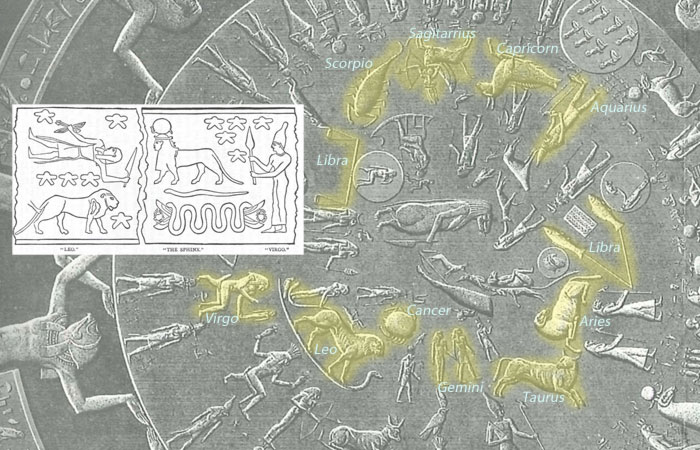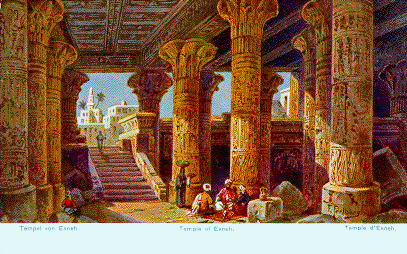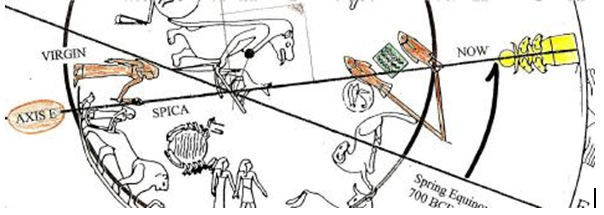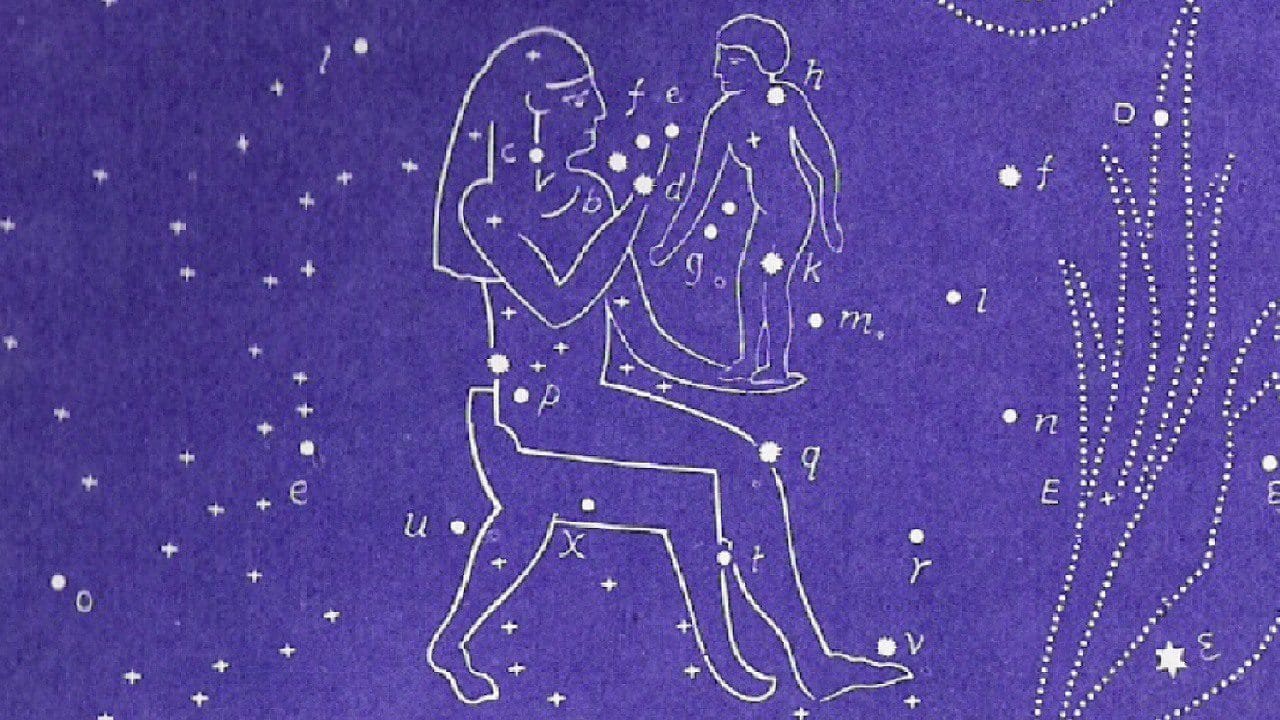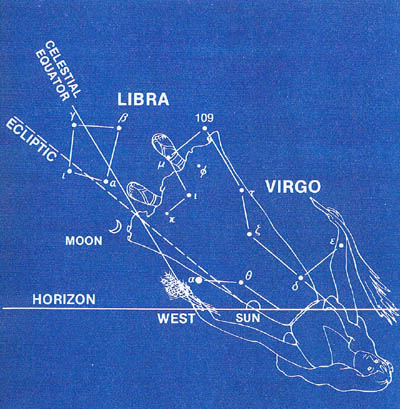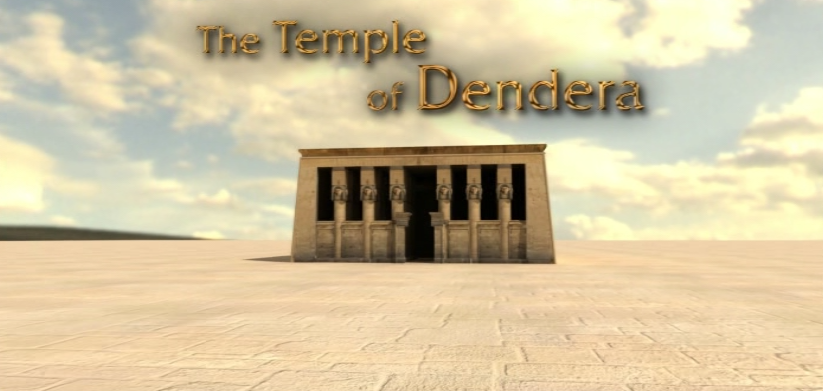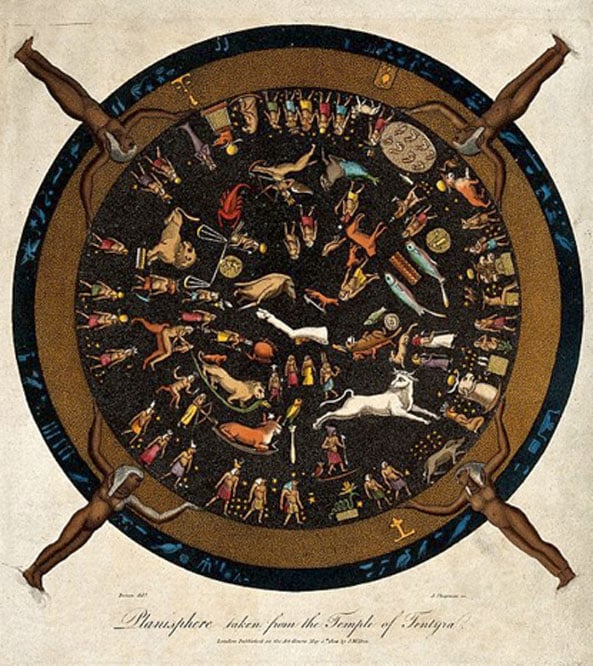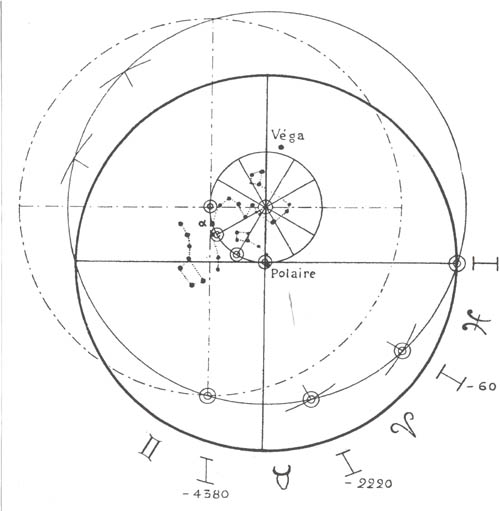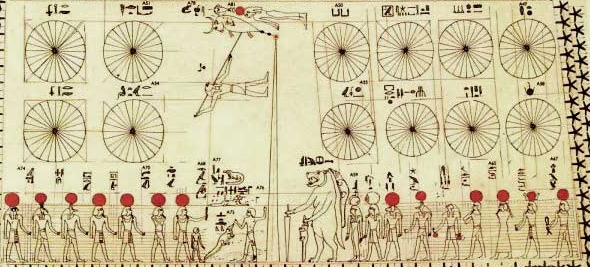
Luke 11:29-30
29 And when the people were gathered thick together, he began to say, This is an evil generation: they seek a sign; and there shall no sign be given it, but the sign of Jonas the prophet. 30 For as Jonas was a sign unto the Ninevites, so shall also the Son of man be to this generation.
The Presence of Jesus Christ 2000 years ago, was a sign to that generation that fulfilled all the Messianic OT Prophecies, including the Gospel in the Stars, in agreement with God’s Word. Jesus embodied the eternal purpose and God’s Plan of the Ages, to redeem mankind, which is exactly the story related in the Gospel of the Stars, as a precursor to the Scriptural record. Thus, as we take a unified view of the various categories of Heavenly Signs, we are much better served as opposed to a segregated view of these categories, as signs unto themselves. In this way we are not seeking after individual signs, but are aware of them as a general category, placing them in a proper biblical context to glean their meaning and message.
As we can see from the example above, not all Biblical “signs” are astronomical in nature, but that does not mean there is no astronomical connotation that could exist for a biblical sign, as we find above. The Hebrew word in Strong’s [H226] means a “sign, token, badge, standard, monument, warning, omen, symbol, miracle or proof.”1 In Gen. 9:12-17 it indicates God’s Promise in the Rainbow after Noah’s Flood. Also as His Covenant was confirmed by circumcision, [Gen. 17:11, Rom. 4:11]. The Great Pyramid was also a prophetic sign of Jesus Christ, [Isa. 19: 19-20]. There are astronomical signs; of various types, [2 Kings 20:8-9]. As we see other types of Biblical signs above, we find a strong biblical basis for various types of signs designed to get our attention. According to a Lexical Aid to the OT, This word can refer to anything showing or confirming a past, present or future event. 2 Thus, whenever these events are confirmed by signs from the Hand of God, it demands our full attention!
This blog is third in a series of rebuttals against the critique of Frances Rolleston’s work of The Mazzaroth, by Dr. Danny Faulkner, who has categorized heavenly signs on his own, naming 4 types of signs listed below.
First, Faulkner recognizes what we would call a “sign of the times” as Jesus taught in his parable of Matt. 16:1-4. The idea that this is a specific type of Parable where Jesus taught spiritual truths from natural scientific phenomena is noteworthy. This illustrates how the Creator intelligently designed His systems in Creation, to depict His Almighty omnipotence and wisdom. Second, as Psalm 8, Psalm 19, and Romans 1:18–20 tell us, God’s existence is revealed through the heavens, constituting a category of Celestial Sign. This can also reveal God’s purposes in His Creation, as we see with His plan to redeem mankind through His only begotten Son, not only as the main theme of the Gospel in the Stars, but also God’s Word. Third, the star that led the Magi to the infant Jesus (Matthew 2:1–2, 9–10) was undoubtedly a sign from heaven. This illustrates how the Almighty utilized specific celestial signs to mark the birth of Christ, His only begotten Son, to carry out the primary purpose of His plan and goal to redeem mankind. Fourth, there will be signs in heaven that reveal God’s wrath (Isa. 13:9–13; Joel 2:30–31; Matt. 24:29–31; Mark 13:24–27; Luke 21:25–28; Revelation 6:12–17). 3 Under this category heading Faulkner includes signs of the end times and the Return of Christ, but there are also signs like Blood Moons which Faulkner lumps together here in [Joel 2:30-31] above, that are not always indicators of God’s wrath. You can also include Meteor Showers, one of which played a notable role in the signs around the birth of Christ. Thus, in these categories we have at least six types of possible signs in heaven and heavenly bodies that conform to the God-ordained purpose for them. We have classified another dozen types of signs that are referenced below. In the face of how these categories of Celestial Signs work together with the Gospel in the Stars, to fulfill God’s primary purpose, Faulkner succumbs to the blindness of his segregated view of these categories of heavenly signs by saying; “With no clear biblical support for these signs being the Gospel in the stars, it is pure conjecture that Genesis 1:14 requires that there be a Gospel in the Stars.” 4 Genesis 1:14 does not “require a Gospel in the Stars” but by the nature of the story related by the 12 constellations with their decans, this record in God’s Word attests to a strong foundation for the Celestial Gospel, supported by Biblical Heavenly signs.
A Recent Blood Moon over Jerusalem.

Regarding the Star of Bethlehem, Faulkner states; “If, as most scholars think, the Magi were Persian, they likely had read Daniel’s prophecy of 70 weeks and hence knew that the time of the Messiah’s arrival was nigh. In fact, the Magi were not the only people who were expecting the Messiah at that time, for many Hebrews were looking for the Messiah as well. We do not know what the star that the Magi saw was, but supporters of the gospel in the stars want us to assume that it must have had something to do with the gospel in the stars. This is all a bit muddled though, because many supporters of the gospel in the stars believe in some astronomical event, such as an unusual planetary conjunction was the star. If that sort of thing was the star, then did the Magi really require the gospel in the stars? 5
Faulkner does not seem to think that a Gospel in the Stars is biblically “required,” so he proposes a number of scenarios to cast doubt on its validity. Proponents of the Celestial Gospel however, recognize the key role that the Stars fulfill in support of God’s witness to mankind, not only of God’s existence, but also as Creator. At least Faulkner is forthright enough to admit that he does not know what the star seen by the Magi was. However, as we have advocated and documented since the 1980’s, in our study of the signs marking Christ’s Birth, it becomes apparent that Jupiter was the planet that the Magi referred to as “his Star” in Matthew 2:2. The Magi had noted the triple union of signs in 7-6 BC, involving Jupiter and Saturn, that provided them a blueprint for the actual signs marking Christ’s birth, starting in 3 BC. An early sign in August of 3 BC motivated them to begin their caravan to Jerusalem. Both of these aspects of the General and Specific celestial signs marking the birth of Christ are apparent in the study on “The Stars Over Bethlehem,“ which provides further details of what the Magi observed in the skies overhead marking the Messiah’s birth, both in Virgo and Coma, pictured in the title banner of this blog above.
The clear biblical astronomy support for the Gospel in the Stars could not be in plainer sight, but was still missed by Faulkner, seen in the correlation of two of the categories of celestial signs he points out. First, the evidence we have presented regarding the birth of Christ above, with the Celestial Gospel, and how the monuments of the Giza Plateau, like the Great Sphinx as a memorial for the Alpha/Omega constellations of the 12 signs of the Mazzaroth–Virgo and Leo, show the Sphinx and the Great Pyramid prophesy of the birth of Christ, providing a strong suit for the function of these ancient monuments. Secondly how, these constellations of Virgo and Leo marking Christ’s birth point to the Great Sphinx, with various planetary unions seen in the Celestial Sphinx, and also how the Great Pyramid witnesses to these aspects of the Celestial Sphinx with heavenly signs in Sept. 2017, give conclusive proof of the sacred function of the oldest man-made wonders on our planet’s surface. In our last blog we referenced a key astronomical function of the Great Sphinx, in its Pre-dynastic stellar role as a sighting device linked to its astronomical functions, to observe and record the horizon points of the sunrise, found not only in the Sphinx’ orientation facing due east, but also in relation to the tropics of Cancer and Capricorn.
The Great Sphinx
The Sphinx’s solar alignments relating to the borders of the tropics, depict ancient knowledge of the zodiacal band, within which the heavenly bodies named by the Creator [Ps. 147:4, Gen. 37:9-11, Isa. 40:26, Job 9:7], shed their 3-fold light upon the Earth. God set the tropics of Cancer and Capricorn, as boundaries within which the Sun, Moon and Planets all move, above and below the celestial Equator. Thus, it is the stars within the Zodiacal Band that God marked to carry the message of His Gospel in the Stars, and His eternal plan and purpose for mankind’s redemption.
We find added biblical evidence of this truth in Joseph’s second dream [Gen. 37:9-11], in an astronomical context.
Gen. 37:9-11 9 And he dreamed yet another dream, and told it his brethren, and said, Behold, I have dreamed a dream more; and, behold, the sun and the moon and the eleven stars made obeisance to me. 10 And he told it to his father, and to his brethren: and his father rebuked him, and said unto him, What is this dream that thou hast dreamed? Shall I and thy mother and thy brethren indeed come to bow down ourselves to thee to the earth? 11 And his brethren envied him; but his father observed the saying.
In this second dream of Joseph, we find evidence of the knowledge of the zodiacal band with the Biblical Patriarchs, since the 11 brothers of Joseph appear as the 11 stars with Joseph being the 12th constellation, summarizing the main signs found along the path of the Sun and Moon, embodied in his parents. This ancient knowledge of the zodiacal band among the Biblical Patriarchs, is another proof of the Gospel in the Stars in concert with Scripture and the Great Sphinx, that corroborates the historic signs from Giza not only of Christ’s birth, and first coming but also, points to the Return of Christ, and his Second coming. This also links another type of celestial sign showing the Blood Moon tetrads, as another category of Biblical Celestial Sign tied to the history of Israel and Jerusalem. These heavenly signs fall in the category of a Celestial sign including many Jerusalem prophecies that have recently been fulfilled, so we can truly recognize these “signs of the times,” as Jesus taught in Matt. 16:1-4.
God’s Revelation in the celestial gospels features 48 constellations, which include the 12 Signs of the zodiac, along with their 36 decans. These star-pictures were drawn around and associated with their specific star groups, starting with the earliest Bible Patriarchs, so that they would be handed down and remembered throughout the ages. In [Gen. 1:14] the lights in the firmament of Heaven were to be for “signs, seasons, days and years.” The word for “signs” [H226-owth] 6 is the same Hebrew word that refers to 12 constellations of the Mazzaroth. These signs were afterward, [Gen. 37, 49, Num. 2, Deut. 33] identified with the 12 sons of Jacob, representing the 12 tribes of Israel, providing a direct link, between the Gospel of the Stars and these Signs. In Joshua 4, when the nation of Israel first crossed into the Promised land, there was a special “sign” [H226] that occurred where this notable occasion was marked by the Hand of God, and 12 special stones representing the 12 tribes of Israel were used to build a memorial to honor God, who brought Israel through the wilderness. Thus, even though this sign was not astronomical in nature, it still carries astronomical ramifications due to being linked not only to the 12 tribes, but also to the 12 stones, [Eben-H68] of this memorial.
Joshua 4:5-9 4 Then Joshua called the twelve men, whom he had prepared of the children of Israel, out of every tribe a man: 5 And Joshua said unto them, Pass over before the ark of the Lord your God into the midst of Jordan, and take you up every man of you a stone [H68-Eben] 7 upon his shoulder, according unto the number of the tribes of the children of Israel: 6 That this may be a sign [H226] among you, that when your children ask their fathers in time to come, saying, What mean ye by these stones? 7 Then ye shall answer them, That the waters of Jordan were cut off before the ark of the covenant of the Lord; when it passed over Jordan, the waters of Jordan were cut off: and these stones shall be for a memorial unto the children of Israel forever. 8 And the children of Israel did so as Joshua commanded, and took up twelve stones out of the midst of Jordan, as the Lord spake unto Joshua, according to the number of the tribes of the children of Israel, and carried them over with them unto the place where they lodged, and laid them down there. 9 And Joshua set up twelve stones in the midst of Jordan, in the place where the feet of the priests which bare the ark of the covenant stood: and they are there unto this day.
The Hebrew word for stone [H68-Eben] in Joshua 4:5 above, is the same word used for the 12 precious stones on the breastplate of the High Priest, both linked to the order of the 12 tribes [Exod. 28:10-11, 39:6-14] seen not only in the breastplate of the High Priest, but also in the order of encampment the 12 tribes in the wilderness, [Num. 2:2ff] around the Tabernacle, in their Cardinal Directions as follows:
1. VIRGO–Zebulon, Woman, Ship, carrying God’s people to safe harbor. [Deut. 33:18]
2. Libra–Levi– Priesthood, Judgment. The Scales balanced in the redemption of Christ’s Blood.
3. SCORPIO-DAN [NORTH] [Gen. 49:17] a serpent by the way, with Ophiuchus/Serpens decan.
4. SAGITTARIUS-ASHER; Crown of Life to the world, His bread shall be fat, as the Gospel Carrier. [Deut. 8:3]
5. CAPRICORN-Gad, Overcoming Troop [Deut. 33:18-19]
6. AQUARIUS-REUBEN [SOUTH] [Gen. 49;3-4] “unstable as water”
7. PICSES-SIMEON, [Gen. 49:5-6 & Levi] as brothers were not to be united, since together they killed a man.
8. ARIES– NAPHTALI means “struggle.” but the end of Naphtali alone is Taleh, a Lamb, [Jn. 1:29].
9. TAURUS–Joseph, EPHRAIM & MANASSEH [TWO HORNS OF THE BULL] (WEST) [Deut. 33:16-17]
10. GEMINI–BENJAMIN, Named Benoni as Rachel died birthing him, [sufferings]. Renamed by Jacob Son of my right hand-[Glory].
11. CANCER-ISSACHAR, [Gen. 49:14-15] A Strong Ass between 2 burdens.
12. LEO–The Lion–Judah [EAST] [Gen. 49:8-10] Juda is a Lion’s whelp.
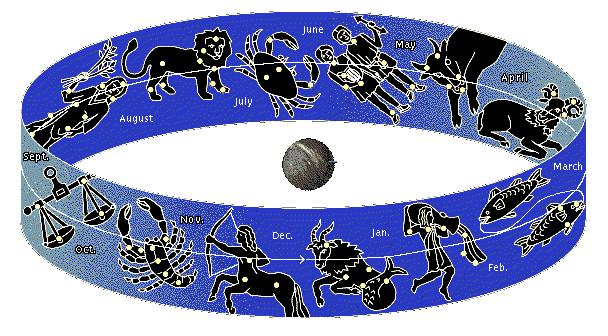
Thus, we find the general relation between the Blessings for each of the 12 Sons and the 12 signs of the zodiac in Gen. 49 and Deut. 33. When we allow God’s Word to speak for itself, and not rely on Theological Commentaries as our “go-to” primary resource in Bible research, the Scriptural witness will be clear. Since Joshua 4 links the same word for 12 Sons & signs of the zodiac, with the 12 stones of their memorial entrance into the promised land, we find a biblical link between the 12 signs of the zodiac with the 12 tribes of Israel, each tribe with their own sign and stone. This is not my opinion or conjecture, but Scriptural truth. The same word for “stone” [H68] is used in Ex. 28, in reference to the breastplate of the High Priest, where the names of the 12 tribes are engraved-6 each, on the shoulder onyx stones according to their birth order, [Ex. 28:10-11]. Just as there were 12 main gates in the city of Jerusalem, so there are also twelve gates and twelve foundation stones in the New Jerusalem, (Rev. 21:12-14). The order of the tribes not only matched the order of their wilderness camp, [Num. 1:52] but also includes their own tribal Standard, [H1714-degel] 8
flag or banner, for each tribe. This is crystal clear in;
Numbers 2:1-2 And the Lord spake unto Moses and unto Aaron, saying, 2 Every man of the children of Israel shall pitch by his own standard, [H1714] 9 with the ensign [H226] of their father’s house: far off about the tabernacle of the congregation shall they pitch.
Contrary to Faulkner’s opinion, there is no mystery as to what is depicted on each of these tribal banners or flags! Num. 2:2 tells us plainly that every man pitches by his own standard with the ensign [H226] of their father’s house. The word for ensign is the key being the same Hebrew word used in [Gen. 1:14, Josh. 4:5-9] linked to the 12 signs of the zodiac, each of the 12 banners with the emblem of their tribal constellation. In Psalm 74 this point is driven home so there is no doubt;
Psalm 74:4 Thine enemies roar in the midst of thy congregations; they set up their ensigns for signs.
Even the enemies of Israel “pitched” under the colors of Israel’s tribal banners in order to infiltrate them. Both the Hebrew words for “ensigns” and “signs” in this verse are the same word [H226]. So they lifted up their banners or tribal flags emblazoned with their family sign of the 12 “signs” or constellations of the zodiac. Thus we can see how Scripture records what images were on these standards.
Faulkner references Rolleston’s “problems with the zodiac in the Bible, stating; “the alleged parallels between the blessings for each son and the zodiacal signs are extremely creative. The only obvious possible connection is the one supposedly between Leo and Judah in that Judah is referred to as a lion. However, there is not even a hint of the other 11 links that Rolleston makes to Genesis 49. Rolleston speculated that each son carried a symbol from one of the signs of the zodiac and that Jacob pointed to each zodiacal symbol in pronouncing his blessing. This is entirely speculation on Rolleston’s part, and I have found no commentary that mentions, let alone endorses, this idea.”10

As we can see in our Zodiac list above, the correlations between the 12 tribes and 12 signs from Deut. 33 and Gen. 49 are much more congruent than Faulkner cares to admit, but God’s Word says nothing about Jacob pointing to the signs with his blessing, a pure fabrication. In Faulkner’s critique of Rolleston, she claimed the same correspondence between the tribes of Israel and signs of the zodiac is contained in the final blessing of Moses in Deut. 33 (Rolleston 1865, part 2, p. 38). Here and elsewhere (Rolleston 1865, part 1, p. 12, part 2, p. 48) Rolleston further claimed that in the wilderness each of the tribes carried a standard with the tribe’s respective zodiacal sign inscribed upon a standard. It is true that the tribes had standards, or banners, (Num. chapter 2 and 10), but Scripture does not record what was on the standards.”11
Faulkner’s views on Virgo and the “virgin birth” are included as follows; “Exhibit A is Virgo, which many take as an obvious analog to Mary. But is it? The prophecy of the virgin birth is from Isaiah 7:14, written a little more than seven centuries before fulfillment. Isaiah was written long after the gospel in the stars supposedly originated, but there is no biblical evidence that there was any other prophecy or expectation of a virgin-born Messiah prior to Isaiah. Given the high value of virginity, it is not surprising that a virgin might show up among the constellations. A virgin with a child in the ancient constellations would have been quite unusual, and so perhaps might have been a good argument for the gospel in the stars. Rolleston understood this, and so she was very creative is claiming that just such a thing did exist. But, alas, she did this with quite a bit of sleight-of-hand, by moving an unclear figure from the Dendera planisphere to a new location and suggesting a false history to accompany it.“12
The first problem with a “virgin birth” is that it not a Biblical Doctrine, since the Bible teaches a virgin conception. Mary was not married to Joseph at the time of the Almighty’s visitation on her, which was prior to their marriage. Faulkner’s comments on the “Virgin Birth” are included below, and as he points out “A virgin with a child in the ancient 12 signs would have been quite unusual, and so perhaps might have been a good argument for the gospel in the stars.”13 In support of this, we have already shown regarding the Coma Decan on the Dendera zodiac, there is nothing “unclear” about how the Coma decan is depicted on this planisphere, accept in Faulkner’s mind, because it contradicts his disbelief in the Celestial Gospel. Neither was the Coma Decan “moved to a new location” as it appears in alignment with Axis E on the Dendera zodiac along with Virgo’s Seed, witnessed as a stalk of grain on the Dendera planisphere. This picture of the promised seed as a young boy in the Virgin’s lap for this very reason was the celestial depiction of the virgin’s seed, in agreement not only with Gen. 3:15 but also Isa. 7:14, as an excellent case for the Gospel in the Stars. Once any honest reader sees the evidence on the Genesis 3:15 Planisphere Axis below, all doubt is removed regarding the validity of the Gospel in the Stars.
The unity of the Gospel in the Stars with God’s Written Word is evident on many levels, but those disclaiming the validity of the Celestial Gospel are blinded to this truth. Psalm 19 is a key chapter of Scripture that not only attests to the existence of the Almighty Creator, but also displays how the houses of the Sun referring to the 12 constellations of the Mazzaroth, provide the circuit-[ecliptic] where the Sun of Righteousness [Mal. 4:2] lives, moves and has his being. In this way, the heavens still speak to us today according to the principles of Biblical Astronomy, as the Sun. Moon, planets and Stars have their voice.
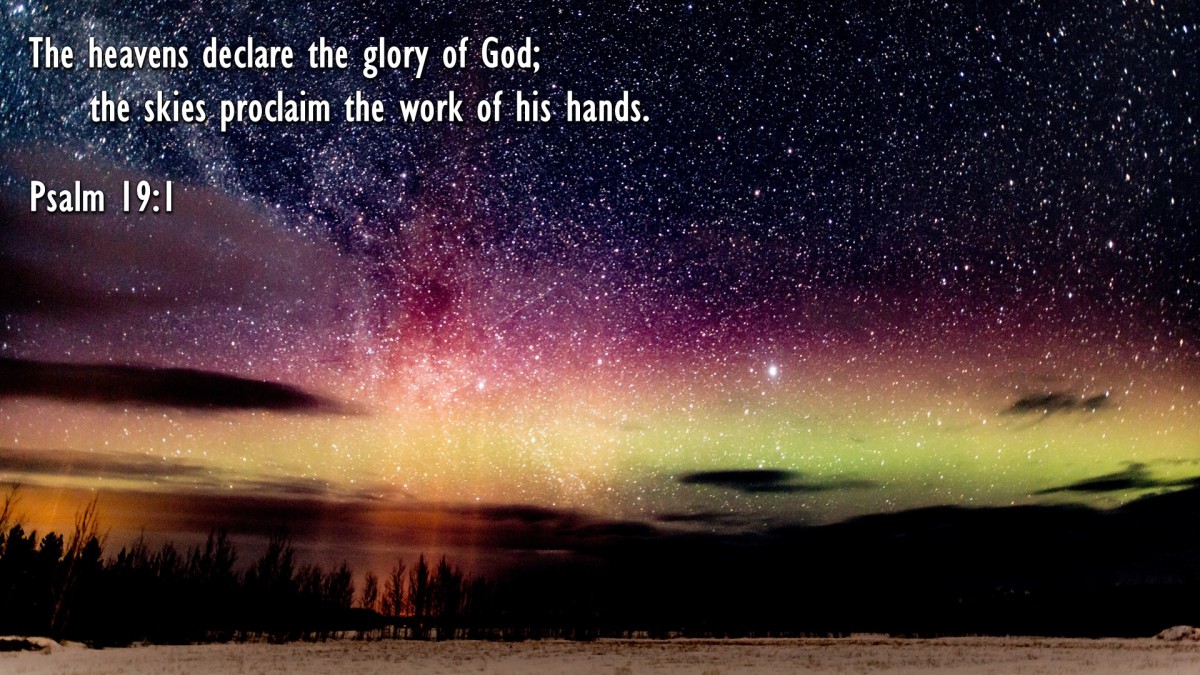
Psalm 19:1-6 “The heavens declare the glory of ELOHIM. (CREATOR)
The verbs in this section are literary, then in vs. 7 they transition to the astronomical.
A Literal translation according to usage of Psalm 19:1-4 reads as follows:
v.1 “The heavens continuously [all the time, not sporadically] go over and over, again and again, rehearsing the glory of God, the Creator [Elohim], and all of God’s expanse keeps setting forth God’s great handiwork in the heavens.”
v.2 “Day in and Day out, the heavens are continuously pouring forth, telling and prophesying; and, night after night, the heavens continuously pour forth intelligent information.”
v.3 “There is no speaking forth by way of the heavens, nor words they pour forth in all the earth, where the words the heavens pour forth have not been heard.”
v.4 “The heavens allotted measurements (Zodiac-signs & seasons in Gen. 1:14) have gone over all the created earth, and the teachings of the heavens have gone all over the inhabited earth. In the constellations hath He established a tabernacle for the sun,”
notes on v.4 “line”= [qav] prophecies, also a survey line denoting the ecliptic or direction of the sun through the heavens, and the lines marking the “decans” within the zodiacal houses of the sun. This is the universal standard of timekeeping and the basis of numerous cultural calendars throughout history. Also the lines of Latitude and
longitude on the face of the earth are found here, corresponding to these measuring lines, ordering the Heavens and reflected upon the Earth. [Rom. 10:17-18]
“In them“=the heavens
“tabernacle“=houses of the sun. [mansions of the 12 signs of the mazzaroth]
v.5 And he as a bridegroom embarking from his bridal canopy (pavilion), like a champion rejoices to run his course.
notes on v. 5…The oriental wedding would conclude with the groom leading the bride out of the canopy (indicative of God’s protection) after the marriage ceremony. This also is a figure for Christ-The Bridegroom, courting his Bride–Israel [Not the New Testament Church of his Spiritual BODY].
v.6 Its rising is at one end of the heavens, its circuit reaches from one end to the other, and nothing [yes, no one] is hidden from its heat.
v.7 “The law of the Lord is perfect”=JEHOVAH’S Word in relation to His creation. [Here is the transition from literary to astronomical verbs]
“converting the soul”=returning as the sun returns in its circuit, so God can restore and heal every aspect of the soul life of a man, in the process of complete salvation wholeness.
v.8 The testimony of the Lord is faithful [as the sun is a faithful witness in the heavens Ps. 89:36-37] making wise the simple. The precepts of the Lord are right rejoicing the heart. The commandment of the Lord is pure enlightening the eyes.
notes on v.8 “enlightening”=as the sun. {Isa. 60:18-19, II Pet. 1:19 “daystar”} The celestial bodies shed a 3-fold light upon the earth!
“testimony”-a repeating witness also as the Sun on the ecliptic.
v.9-10 The reverent fear of the Lord is clean, enduring forever. The ordinances of the Lord are true and righteous altogether. More to be desired than gold, than much pure gold, they are sweeter than honey dripping from the honeycomb.
“clean”=active continual cleansing.
“true”=faithful in perpetuity
v.11 By them your servant is warned [reminded, illuminated and instructed] and in keeping them there is great reward.
“By them”=in them [moving & dwelling in the ordinances of the Lord, for in them we live & move & have our being] even as the sun lives and moves in and through the houses of the zodiac.
“warned”=instructed as in II Tim. 3:16 by Doctrine, Reproof and Correction.
“keeping”=observing or watching as the stargazers and Biblical astronomers observe the heavens to learn its lessons and secrets. Even so the planets and celestial orbs observe the Creator’s ordinances as they remain in their ordained orbits.
v.12-13 Who can discern their lapses and errors? Clear and restrain me from unconscious faults, let them not have dominion over me.
“errors”=wandering within ordained limits as the planets in their orbits, like the tropics of Cancer and Capricorn.
“dominion”= to rule over as the sun rules over the day and the moon over the night [Gen. 1:18].
v.14 May the words of my mouth and the meditations of my heart be pleasing in thy sight, O Lord, my Rock and my Redeemer.
The Stars in their courses and the planets in their orbits, cycle through seasons of change in their orientation to the Sun. As the planets seem to “wander” in their appointed courses, ordered by God according to the phi ratio, like a sine wave they move both closer to, and farther from the Sun’s light. Even so, man in his growth and maturation process “wanders” on the path towards God’s light, and his physical and even spiritual growth also, is ordered by the same phi ratio. As we discern these orbits and their planetary lapses, we are enlightened, warned and instructed in our walk with the Lord. There is abundant grace and mercy in God’s forgiveness, even as a child stumbles and falls before he walks, and walks before he runs. As we learn to walk closer with our Maker, and run to serve His perfect counsels and purposes, we lend our voice to the growing chorus of the Body of Christ, walking the paths of the holy, while avoiding the snares of the evil one, until that long-awaited day when the Lord returns for us in the ultimate victory of the ages. This is some of the key teaching we can glean from the Celestial Gospels, as they exhibit some of the strongest evidence for the reality of our Almighty Heavenly Father and Creator.

Other categories of Celestial Signs we have documented on this blog since 2015 include:
1. Solar Eclipses; [3/20/15, 8/31/15, 9/1/16, 6/24/17]
2. Nova’s; [4/6/15]
3. Supernova’s; [11/20/15, 11/1/2018] Celestial Prelude;
4. Planetary Alignments; [1/24/16] Birth of Moses
5. Blood Moon Tetrads; [3/30/15, 5/16/15, 6/15/15, 5/31/16, 10/4/17, 6/21/18, 11/1/18]
6. Planetary Conjunctions; [7/26/15, 10/7/15, 6/30/16]
7. Mercury Transits: [4/30/16, 11/10/19]
8. Comets; [12/13/16, 11/1/16, 9/10/18]
9. Super Moons; [1/15/18, 2/08/18]
10. Lunar Occultations; [10/1/18, 3/1/20]
11. Earthquakes; [7/13/19, 1/17/20]
12. Gospel in the Stars; [4/23/20, 5/8/20]
*Please check the linked blogs under each category of Heavenly signs for greater Biblical details on each type of sign.
Problems with Faulkner’s Interpretation of Orion
The name Orion appears three times in the Bible (Job 9:9, 38:31; Amos 5:8). Rolleston correctly noted that Chesil is the Hebrew word translated as “Orion” in all three uses (Rolleston 1865, part 2, p. 30). “Rolleston viewed Orion as a type of Christ. Part of this came from the name “Orion. The meaning and source of this name is obscure, but, according to Allen (1963, p. 304), it comes from Akkadian, and means “Light of Heaven,” an apparent appeal to Matthew 4:16 on Rolleston’s part.”14 Faulkner references various mythologies and legends where some of those stories have Orion stung on the foot, but others do not specify where the scorpion stung Orion.”15 We are more concerned with the star lore from a biblical or Hebraic perspective, although ancient Egyptian myth has proven to contain many of the celestial gospel themes in their original star names and decans. Many of these themes survived the idolatrous corruption of myths linked to the Solar cult of RA and Pharaoh’s ties to it, so that some ancient truths of the Gospel in the Stars still live, for example in the Dendera Zodiac, in the Coma decan prior to its Greek corruption.
As we view the Genesis 3:15 Planisphere Axis in Figure 1 below, we will clear the air of the confusion Faulkner seems to be spreading regarding the Gospel in the Stars. This axis embodies the persistent hope of mankind in the Coming Redeemer, Jesus Christ. Faulkner correctly references Genesis 3:15 as the 1st Messianic prophecy in God’s Word, and as such is a key reference, worthy of a closer look as a foundation to the Gospel in the Stars.
Gen. 3:15 And I will put enmity between thee and the woman, and between thy seed and her seed; it shall bruise thy head, and thou shalt bruise his heel.
Here we have a reference to the seemingly endless struggle between light and darkness, embodied between the serpent and its seed, versus the Woman with her seed. God is telling the serpent that the seed of the woman, who is Jesus Christ would bruise the serpent’s head, indicative of the fatal blow that Christ inflicts on Satan, as opposed to the serpent stinging Christ’s heel, showing Christ’s sacrifice, that freed all mankind from the serpent’s curse. This story from Gen. 3 is depicted in astonishingly powerful ways in the Gospel in the Stars, as seen with this Planisphere Axis below.
Figure 1. Genesis 3:15 Planisphere Axis.
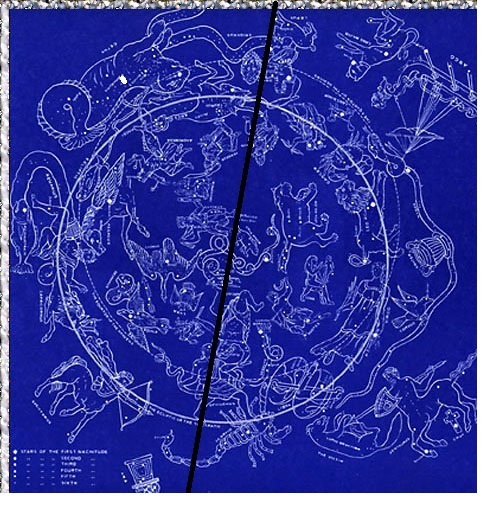
This “Genesis 3:15 axis” extends through the North pole intersecting a number of constellations and notable decans that relate aspects of the Genesis 3:15, theme from various teaching perspectives. Starting at the top of the planisphere, we find the Scorpion constellation–Scorpius, whose prominent tail stinger is positioned just under the heel of Ophiuchus the Serpent-bearer constellation, who is engaged in a struggle with the serpent. The axis intersects the star in Ophiuchus’ heel, called Saiph, in the LXX Greek meaning “bruised.”16 This is the same Greek word used in Gen. 3:15 for “bruised,” while Ophiuchus’ other leg is poised over the head of the Scorpion, showing the fatal blow as he crushes the enemy. This enlargement of Ophiuchus wrestling the serpent for Corona-the Crown of Dominion, while the Scorpion stings his heel, tells us how our spiritual adversary is pictured both as a serpent and a scorpion, in conflict with the man, fitting the three Scriptural elements of the star picture. In Hebrew the Scorpion is Akrab, meaning war or conflict; [Ps. 91:13] with the man.
Figure 2. Ophiuchus, Serpens and Scorpius.
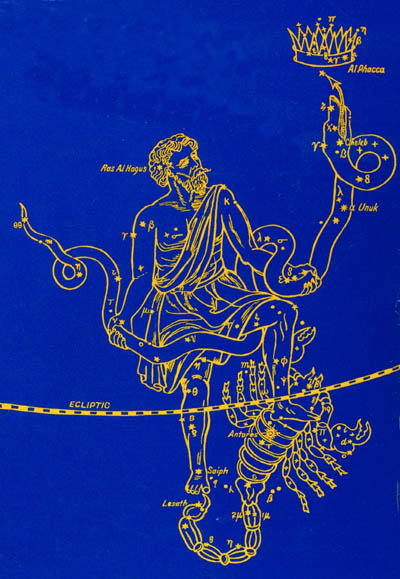
As this axis extends through the next sign, we find it intersecting the decan of Ophiuchus called Hercules, whose foot is placed above the Head of Draco the serpent–dragon at the North pole. The axis runs between the two heads of Hercules and Ophiuchus, who are aligned, but inverted to each other. The star in Hercules head is called Ras Al Gethi, meaning the head of him who bruises, keeping with the Gen. 3:15 theme. 17 As this axis extends down to Hercules left foot, it shows the result of Ophiuchus‘ battle with the Serpent, since Hercules left foot is crushing the Dragon’s head, seen in Fig. 3, destroying the devil’s works. As Hercules is kneeling, his right heel is lifted up as if it was wounded, in some star maps with a spear through his heel. [Rev. 12:9-10, Ps. 74:12-14]
Figure 3. Hercules foot over the Dragon crushing it’s Head. 18
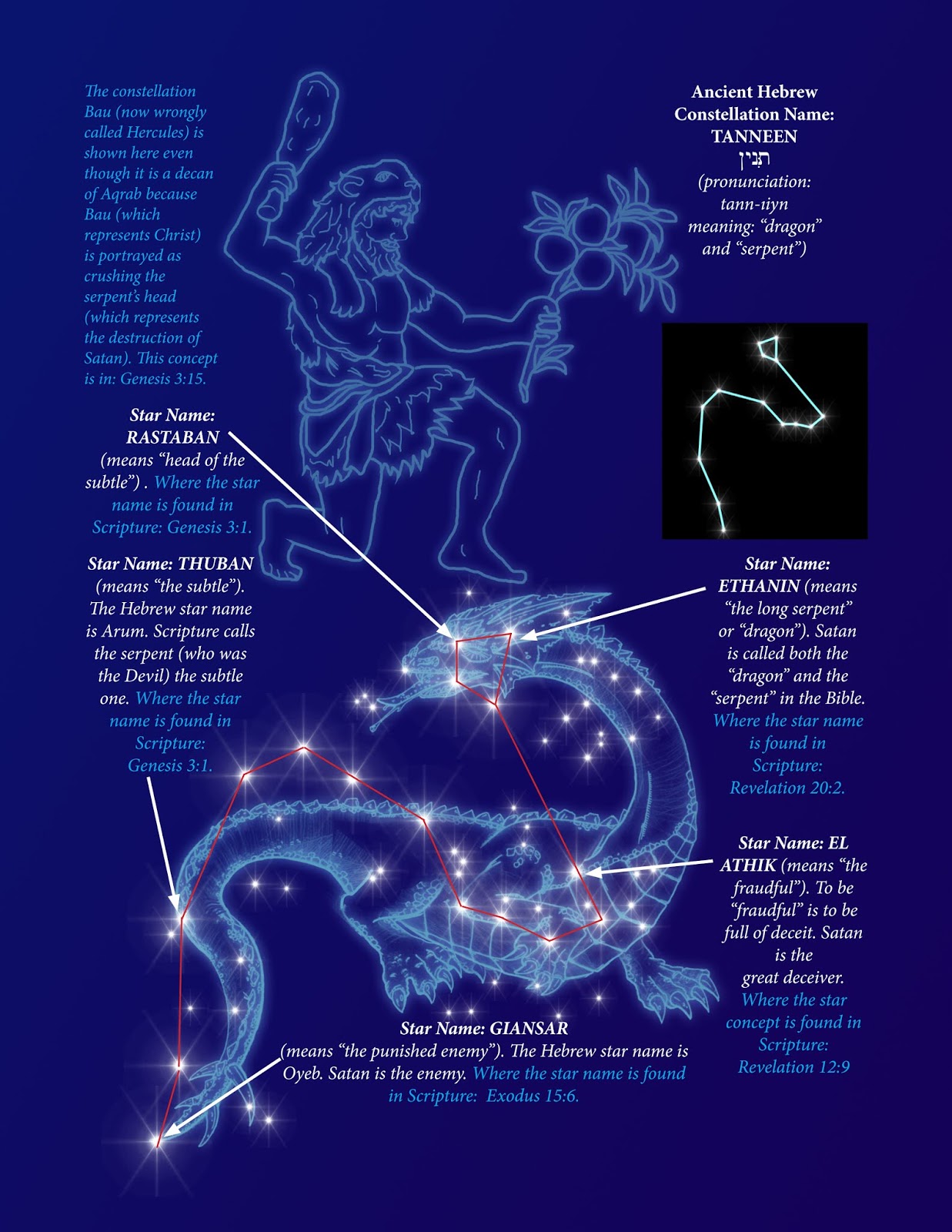
If we now look at the other end of the Gen. 3:15 Planisphere Axis, we find amazingly that it intersects Orion, specifically at the star in Orion’s foot named Rigel, meaning “the foot that crushes,” which is fitting since it is pictured crushing the enemy. The main star in Orion’s other leg incredibly is “Saiph” the same word for bruised we saw in Ophiuchus that is used in Gen. 3:15! Not only do we find both ends of this amazing Planisphere axis agreeing with the same star name tied to Gen. 3:15, but before the axis reaches Orion’s foot, it intersects his the bright star in Orion’s shoulder called Bellatrix, meaning “swiftly destroying,” in reference to the swift destruction of the enemy at the hands of the Lord Jesus Christ. 19
Job 38:31-33
31 Canst thou bind the sweet influences of Pleiades, or loose the bands of Orion? 32 Canst thou bring forth
Mazzaroth in his season? or canst thou guide Arcturus with his sons? 33 Knowest thou the ordinances of heaven? canst thou set the dominion thereof in the Earth?
Figure 4. The decan of Orion, with his foot over the Hare initiating the River of Judgement.
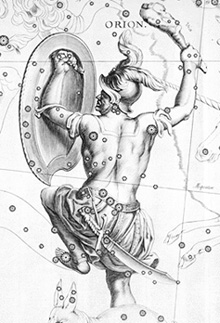
The original meaning of Orion is “coming forth as light.” The same word is used in Genesis. 1:17 and Isa. 60:1, referring to the light of the celestial luminaries.
Faulkner takes exception with Rolleston’s linking of Christ’s identification with Ophiuchus and Orion in the Celestial Gospel, despite the obvious parallels in this stellar depiction of [Gen. 3:15.] But if we let the stars speak, their witness of truth shines through any confusion. Faulkner says that Rolleston “observed that although in most charts Orion’s foot rests upon a hare, in at least one ancient Indian star chart there is snake in place of the hare. Presumably, this snake has bitten, or bruised, Orion’s heal, but he is crushing the serpent’s head in fulfillment of the first Messianic prophecy (Genesis 3:15).”20 Of course, this depiction of a serpent instead of a Hare is not limited to Indian zodiacs, but was also the case in the Dendera zodiac, along with Persian zodiacs as well. 21 As we have seen with the square Dendera Zodiac it is not only one of the oldest planispheres around, as found with its depiction of the Great Sphinx, but it is also a uniquely wonderful source for the identification of ancient decans, that describes Lepus the “hare,” as a serpent. According to Seiss, the Persian and Egyptian zodiacs also include the image of the serpent under Orion’s foot, caught in the claws of a hawk or eagle. 22
According to Faulkner;
“There are several problems with Rolleston’s connection of Orion and Jesus Christ. First is Rolleston’s parallel between Orion dying by means of a scorpion and Christ’s heel being bruised by Satan. For example, the scorpion story is not the only story of Orion’s demise. An alternate ending (Olcott 1911) has Orion swimming away after battle with the scorpion when Apollo tricked Artemis into shooting the dark object in the water (Orion’s head) with an arrow. Only later did Artemis sorrowfully learn that she had killed Orion. Rolleston seemed to select the stories that best fit her hypothesis and ignored others. Furthermore, a scorpion is not a snake. To claim illustration of Genesis 3:15 with a scorpion is a tremendous stretch.”23
Since the Gospel in the Stars is a pictorial representation, that parallels God’s Word, at times they tell a composite story of the truth of Christ. This axis is a good example of a composite pictorial depiction of Gospel truth, that is backed up by the meanings of the individual star names in the constellations and decans of these star pictures. The combined image of this Gen. 3:15 Axis not only presents 3 heavenly giants in combat with serpentine enemies, but there is also a forth decan on this axis shown taking the central star of the heavens away from the dragon’s control. Once the serpent replaces the Hare from later zodiacs, this Gen. 3:15 axis shows a powerful unified image in multiple constellations all centered around the Gen. 3:15 theme.
Figure 5. Draco and Cepheus at the North Pole.
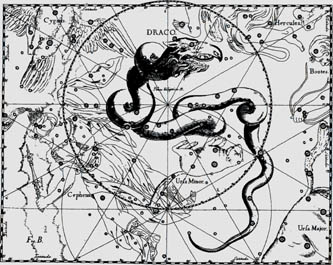
The fourth decan referred to above is Draco the dragon, seen in Figure 5 above, with Hercules’ Foot above its head, inside one of the circles of the Northern Polar Venn Diagram. This is pictured astronomically as the dynamic equatorial pole slowly moves around the static pole of the ecliptic, at the center of the upper circle. The common area between these overlapping polar wheels we find as a vesica of the Venn Diagram. This gives us another viewpoint of the precession of the poles, as the equatorial pole shifted from Thuban, in Draco’s tail to Polaris of Ursa Minor over the past 5000 years. This fulfills the promise of the coming redeemer, as our Gen. 3:15 axis passes through the current pole star Polaris, seen under the feet of Cepheus, the Crowned King, [Eph. 1:20-22]. This celestial image of the King of kings is realized and fulfilled in Christ Jesus, who now presides over the central star of the heavens, formerly under the dominion of the Dragon. Within this Polar circle, we find a triangle that encloses the Little Bear of Ursa Minor. The Triangle roughly consists of the Ecliptical pole at the center of this upper circle, along with two pole stars. One is Thuban the former pole star in the Dragon’s tail on the circle’s perimeter at the upper right corner, and the other is the current pole star Polaris, at the lower-left corner. As we find in Figure 6 below, the Pole star marked Al Ruccaba, is under the foot of Cepheus, meaning “the Branch,”24 exerting his authority over all Creation. Thus the man’s wounded foot has become the instrument of the serpent’s destruction, not only seen in the crushing fatal blow to the serpent’s head, but also is witnessed in the outcome of Ophiuchus’ struggle with the serpent for the Crown [Corona in Fig.2] of Dominion.
Figure 6. Cepheus the Crowned King.

Once again we find the common thread of truth running through this Gen. 3:15 Axis, because in the knee of the leg over Polaris, we have the star Al Rai, which means “he who bruises or breaks,” 25 since it is the man Jesus Christ as King Cepheus, who ultimately breaks the serpent and destroys it. This name Al Rai also marks a star in Orion that matches with Cepheus, just like the star Saiph matches Orion with Ophiuchus on both ends of this axis! This is by design of the Almighty, who named these stars, and aligned them to tell the divine story we are witnessing in the Gospel in the Stars right now! What critics like Faulkner have failed to realize, is that just like the Written Word of God is divinely inspired, so the Gospel in the Stars is also from the same Source. This signature of the Almighty on His handiwork is all the proof required to show the genuine validity of the Hand of the Almighty that underwrites the Celestial Gospel.
Faulkner’s problems with linking Christ with Orion seem to be that they don’t agree with mythology, which would be fine if world myths were the standard for truth. They can be valuable as we have noted, when they preserve the ancient themes of the Biblical Patriarchs written in the Gospel of the Stars, but not so much when they embody the corruption of those truths. As the stories support the biblical theme of the Genesis 3:15 prophecy of Christ, they not only show themselves worthy of our attention, in this case, but other cases also where the constellations and decans reference specific Scriptural themes. As we pointed out, the constellations can use composite truths as seen in Figure 2, where both the snake and the scorpion are pictured in conflict with the man, so the theme of [Gen. 3:15] is upheld as the scorpion and serpent depict it, especially when we take into consideration the other serpents being crushed by Christ figures on this axis! So the standard is, does the stellar image agree with Scriptural truths? Not does it fit our pet thesis, opinion or cultural mythologies.
Faulkner’s use of cultural myths as a basis for interpreting the meaning and message of the stars is an unfortunate example of him accusing Rolleston, Bullinger and Seiss of exactly what he is guilty of; choosing the argument that fit his critique of Rolleston’s Gospel in the Stars thesis. Faulkner’s cursory handling of the Hebrew word and root for Orion is another example. As Faulkner states;
“A third problem with Rolleston’s interpretation is chesil, the Hebrew word used for Orion. Elsewhere this word is translated “fool.” For instance, the eight times that the word fool appears in Proverbs 26, this is the word used. Thus, by the Hebrew name for him, we can see that Orion is not an individual worthy of respect and devotion. To equate this fool with a type of Christ at the very least seriously borders on blasphemy, and most Christians ought to find this offensive. If Rolleston had been as proficient in Hebrew as required to do the word studies that she supposedly did, then she would have known that the Hebrew word for Orion is the same as a “fool.” Instead, Rolleston (1865, part 2, p. 10) claimed that chesil means “bound together,” while Bullinger (1893 p. 125) claims that chesil refers to a great man, but these claims are patently false. Rolleston either was not qualified to do these studies, or she intentionally ignored this blasphemous connection. Bullinger, Seiss, and others ought to have known better than this, but, alas, they did not, or they chose to go with their pet thesis instead. This is an example of gospel in the stars proponents ignoring biblical names for stars, opting instead for pagan sources, because those sources support their thesis.”26
A more in-depth view of the Hebrew Root structure for “chesil” is seen in an analysis from Strong’s Concordance, of this word. If Faulkner would have paid attention to Strong’s handling of this word, he would have known that sometimes a single Hebrew word, can have different usages. In this case “chesil” [H3685] is the name of the constellation Orion, [Job 9:9, 38: 31-33, Amos 5:8], which the orientals call the Giant, perhaps where Bullinger got his “great man” from? They apparently saw this as the figure of an impious giant bound to the sky, referring to Job’s; “canst thou loose the bands of Orion?” Gesenius has a revealing comment and warning that says; [We must not interpret the Scripture as though it countenanced foolish superstition.] 27 Had Faulkner followed Gesenius’ advice here, he could have avoided the bulk of his undistinguished commentary, since much of mythology could be considered “foolish superstition,” [1 Tim. 4:7].
Another usage in this category in reference to Isa. 13:10 is the “Orion’s” or giants of Heaven, talking about the greater constellations of the sky in a Star Atlas catalog. Since Orion is one of the most prominent and visible signs in the sky, it was used as an exemplar for these types of constellations. A third usage of this word [H3686] refers to a town in Southern Judah, along with a fourth usage [H3687] referencing “folly,” [Prov. 9:13]. 28 This compares to what Faulkner discussed [H3684], but he made no references to these other astronomical usages of this word, because it did not fit his rant that people should be offended on the blasphemous ramifications of comparing Christ to a “fool.” Again, Faulkner is the one “ignoring or omitting biblical names for stars like “Orion,” so that he can criticize Rolleston, Bullinger, and Seiss, in their support of the Gospel in the Stars. This also links to another of Faulkner’s criticisms of Gospel in the Stars backers, that we are not adhering to the “Hebrew words closest to the original intended meanings and their soteriological purposes, and thus ought to be central to the Gospel in the Stars thesis.”29 It seems this qualifies as a key example where we make our case for not only the Gospel of the Stars, but also provide a lesson in “not handling the Word of God deceitfully,” expressly for egotistical purposes or self-promotion, [2 Cor. 4:2]. These tendencies from Faulkner only serve to undermine his critique.
The last decan highlighted by our Gen. 3:15 Planisphere Axis, is Auriga, as seen below in Figure 7. Our axis runs very close to the point where the large horn of Taurus, the onrushing Bull pierces the heel of our Shepherd. In keeping with the Gen. 3:15 theme we have found with all the signs and decans our axis marks, here the Bull’s horn strikes the heel of Auriga’s right foot, at the star named Al Nath, meaning the wounded or slain. 30
Figure 7. Auriga The Shepherd. [Jamieson, 1822]
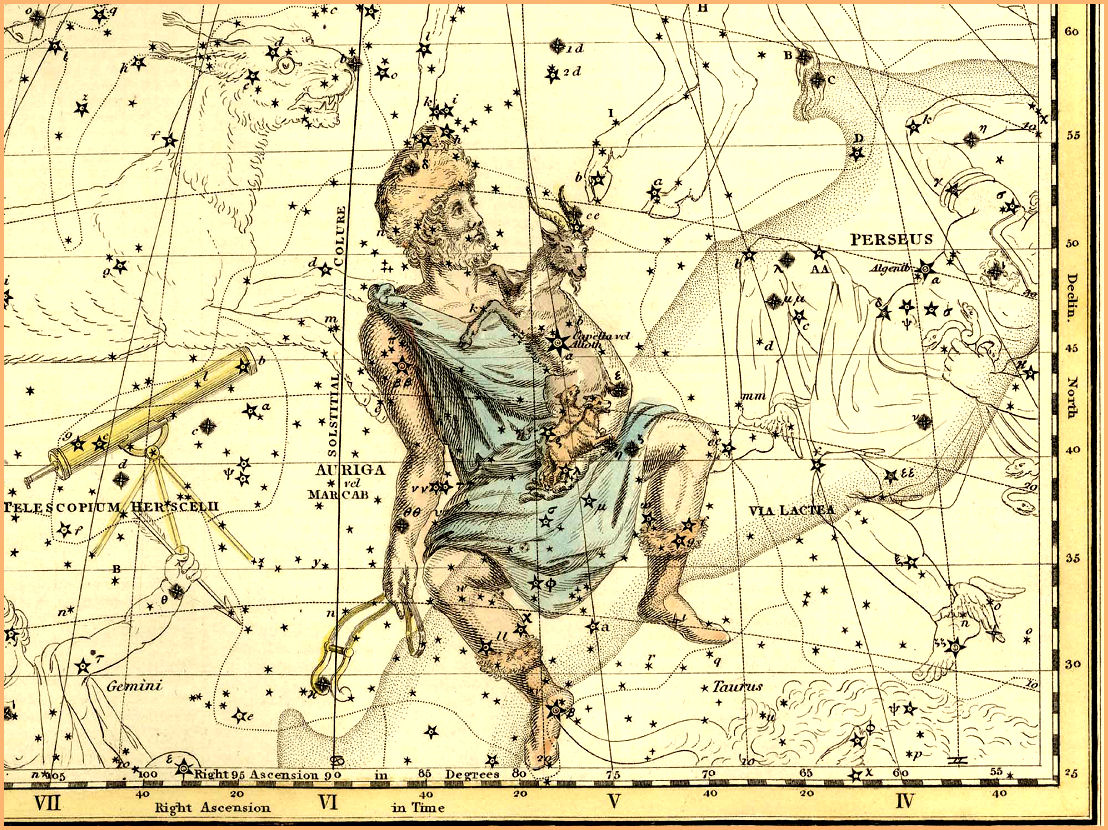
Bullinger says; “He is the Good Shepherd who gave his life for the Sheep, [Jn. 10:11], the Great Shepherd who was brought again from the dead, [Heb. 13:20] and now the Cheif Shepherd, [I Pet. 5:4] seen in the day of his coming glory.” 31 Auriga depicts a picture of the exalted and mighty savior, exercising his loving mercy and salvation in the midst of the scenes of judgment, just as the scriptures tell us that in the midst of wrath he remembers mercy. (Hab. 3:2)
Auriga contains the sixth brightest star in the sky: Capella, the goat star, the chief star in this decan means “She-goat,“32 and marks the heart of the mother goat. She and her kids are scared but they are safe in the arms of the shepherd. Here we see the Shepherd ruling in his authority, rescuing his own from evil, gathering and protecting as a shepherd. With our Gen. 3:15 axis closely by-passing Capella before reaching the tip of the bull’s horn piercing his heel, Auriga sits astride the Milky Way, the symbolic Lord Jesus Christ, the sacrificial lamb who is coming again to execute judgment.
With the conclusion of our Gen. 3:15 axis running down through Orion, we find issuing from Orion’s foot, the River of the Judge-Eridanus, [Hab. 3:5]. This indicates Jesus‘ righteous judgment against the enemy and all the evil ones. Along the course of Eridanus, we find the Serpent-Cetus’, futile attempt to alter or stop the inexorable flow of these waters of 33
judgment with one of its claws. The evil ones will never be able to escape their doom, because of their refusal to succumb to the loving Grace of God in Christ. Thus, their end resides where these waters of judgment pool in the Lake of Fire, or the Second Death. [2 Thess. 1:7-8]
In summary, the Genesis 3:15 Axis provides a panoramic view of the Gospel in the Stars across the expanse of the signs in the Zodiacal band, of the stars named and numbered by The Creator, to relate the infinite theme of God’s eternal purpose carried and fulfilled by His only begotten Son Jesus Christ, as told in the first Messianic prophecy written in God’s Word. The truth as it is presented in the heavens by the Hand of God Himself, is indisputable, to those with eyes to see and ears to hear.
The True Desire of God’s Heart is that all men be saved, and come unto a knowledge of the truth…so it is as we see the final days approaching, we reach out with God’s loving arms to those walking in darkness, to show them the light!!
God Bless!
Rene’

Footnotes
1. Strong’s Concordance, [H226] James Strong.
2. Greek-Hebrew Key Study Bible, Lexical Aids to the OT, [H226], p. 1577
3. https://answersingenesis.org/astronomy/stars/a-further-examination-of-the-gospel-in-the-stars/
4. IBID
5. IBID
6. Strong’s Concordance, [H226] James Strong.
7. Strong’s Concordance, [H68-Eben] James Strong.
8. IBID, [H1714-degel] James Strong.
9. IBID.
10. https://answersingenesis.org/astronomy/stars/a-further-examination-of-the-gospel-in-the-stars/
11. IBID.
12. IBID.
13. IBID.
14. IBID
15. IBID.
16. Witness of the Stars, E.W. Bullinger, p.58
17. IBID, p. 59
18. Figure 3 [picture credit] [http://godsamazingstarsecret.blogspot.com/2019/04/the-fourth-star-family-part-3.html]
19. Witness of the Stars, E.W. Bullinger, ppg.126-127
20. https://answersingenesis.org/astronomy/stars/a-further-examination-of-the-gospel-in-the-stars/
21. Star Lore, Wm. Tyler Olcott, p. 244
22. Gospel in the Stars, Joseph Seiss, p. 116.
23. https://answersingenesis.org/astronomy/stars/a-further-examination-of-the-gospel-in-the-stars/
24. Witness of the Stars, E.W. Bullinger, p. 103.
25. IBID.
26. https://answersingenesis.org/astronomy/stars/a-further-examination-of-the-gospel-in-the-stars/
27. Gesenius’ Hebrew Lexicon to the OT, “chesil” [H3685].
28. IBID, [H3686, H3687].
29. https://answersingenesis.org/astronomy/stars/a-further-examination-of-the-gospel-in-the-stars/
30. Witness of the Stars, E.W. Bullinger, p. 135
31. IBID.
32. IBID, p.134.
33. IBID, p. 129.
General Reference: The Genesis 3:15 Planisphere Axis, is my expanded teaching based on Bob Wadsworth’s original teaching from “A Voice Crying in the Heavens.” Bob is well known for his articles in the Biblical Astronomy Newsletters for many years, a wonderful resource in this field.
Comments on Facebook
To those of you interested in commenting on this post please go to our Facebook Group Page
https://www.facebook.com/groups/bibleastr

